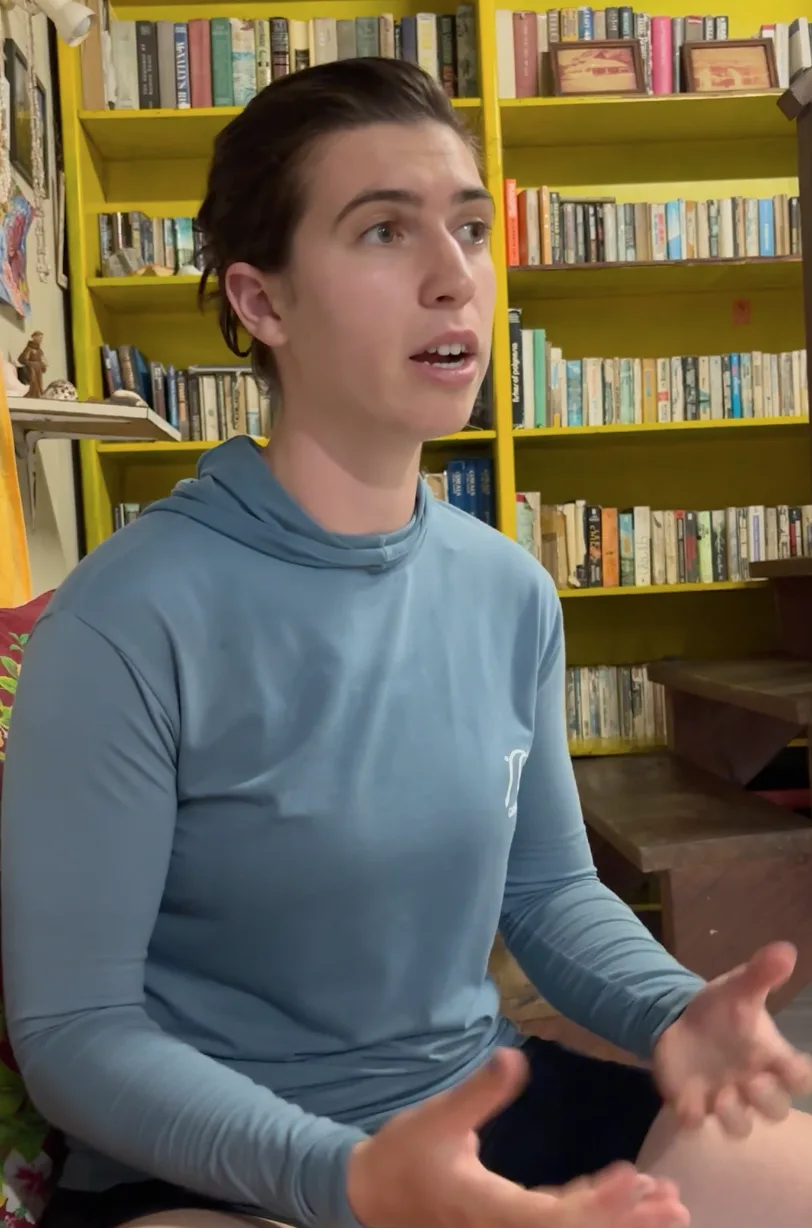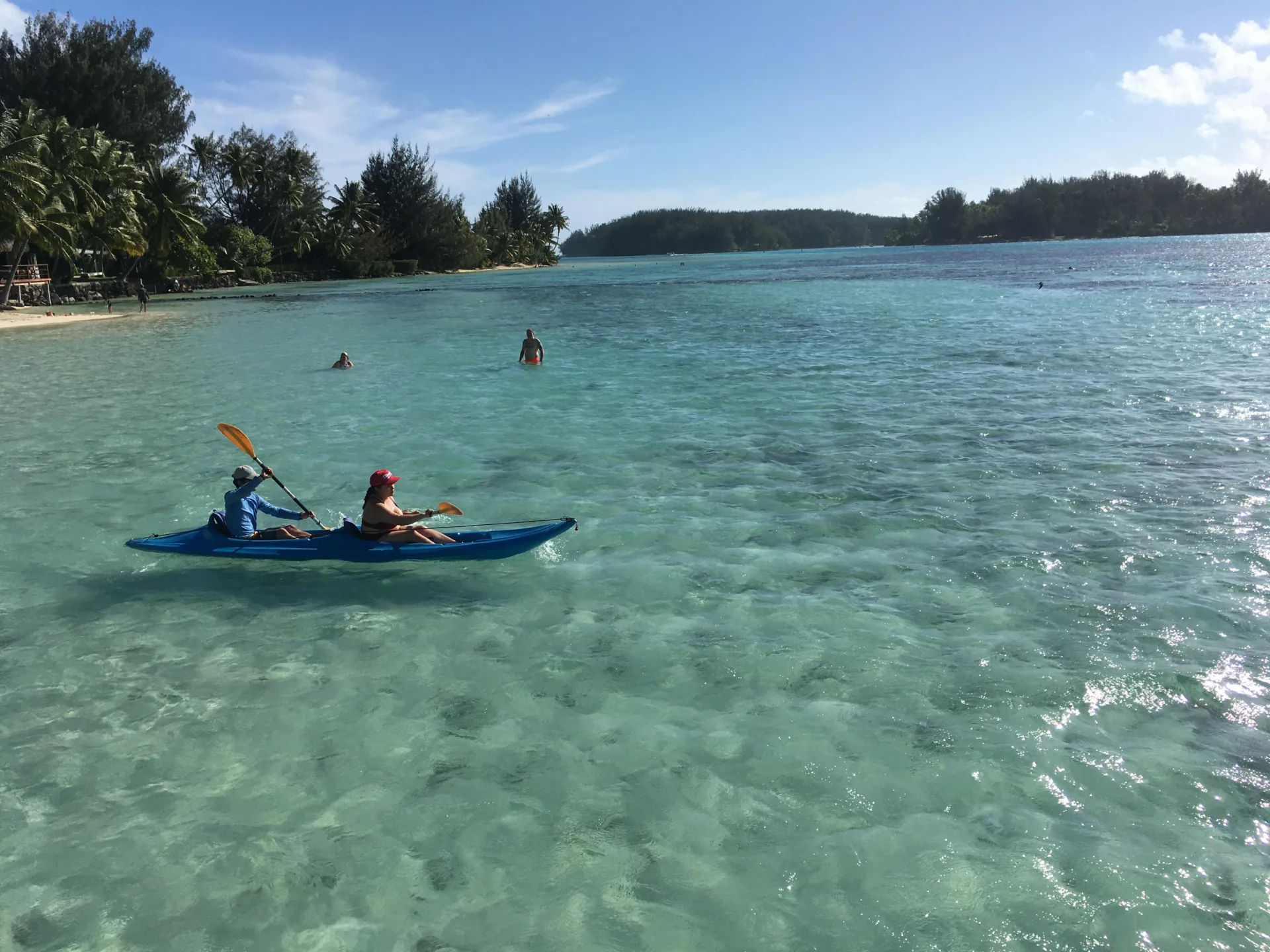Programs Blog
Ana On Learning about Local People, Swimming with Sharks

May 27, 2025
Time: 2000
Location: Gump Marine Station, Mo‘orea
Weather: 88˚ humid, rain squalls
Below is an excerpt of an interview with Ana Hoffman Sole, Cornell University
Could you tell us about where we went this morning?
This morning we went to a local cultural center. They are part of the revival movement of Tahitian and Polynesian culture. We learned about a generation of local people where students were not allowed to speak Tahitian in schools. Their experience was that they were not allowed to speak their native language in schools, punished for speaking Tahitian. That caused fear and trauma associated with these peoples’ cultures that they grew up in. There were multiple reactions to that. One was that some of them did not pass on their language and culture down to their children. Since then, there’s been this effort to bring that culture back. It’s important. The cultural center was founded to focus on children because the idea is that if you can teach kids early, a couple things will happen. First off, they’ll grow up with it and it will be a natural part of who they are, and the second thing is that little kids talk to people. Little kids will go home and say, “Auntie today I learned about rori,” if I remember the Tahitian word right, the sea cucumber, and that will get stories going at home, and they’ll learn more from their own families. It is a really neat center that works in the community.
Did the visit affect how you think about conservation in French Polynesia?
It did. We talk a lot—being Western scientists coming to a place we’re not from and we’ll only be for a short time—about the way that Western science interacts with the places that it goes. So there’s always a lot of conversations about not doing “parachute science,” where scientists come in, take a bunch of knowledge and then just leave without sharing it with the local community. But until you see it, it’s hard to imagine the alternative. Because that’s what I’ve learned about. People going to places, learning things, writing a paper in English, and that’s that. So hearing the story from the perspective of the people who are here, about how scientists can get involved. One of the projects involved water. Some visiting scientists at Gump did a water quality project, and they were working with the community to find places that mattered to schools, shared that information with the schools, with the children. Sometimes the visiting scientists will put together an activity that they will share with the kids around here. So seeing a place where people really are interacting with the community and seeing a place that facilitates that was a positive example that showed me—wherever I go for my career—if you don’t know what to do, this is an example, this is a place that succeeded. That’s really important.
What did you do this afternoon?
This afternoon was a free afternoon for us. I wanted to go to the spot where you can swim with sharks and rays, so we rented kayaks, crossed the channel—these were not sea kayaks and I was doing a very bad job of steering—but we got out there and moored our kayaks. Pretty much as soon as we jumped off you look down and you’re like, Oh, there’s a big pelagic ray there! Look at that!
We were in water that was about five feet deep. I was wondering why the sharks come to this sandy spot that seems to me otherwise unremarkable. I was trying to come up with a bunch of ecological reasons why this might be happening, but not coming up with anything particularly convincing but then towards the end of the time we were spending there we saw people come out in a boat and feed them. Well, that would explain it pretty concisely. That made me have mixed thoughts about what I was doing, because I tend to be of the opinion that maybe we should just let the animals be and not teach them to be hand-fed by humans, especially that six-foot reef shark who doesn’t want to hurt anyone, but one might see how that could end badly! So as much as it was really, really cool to go out there and see these animals, to be in the water with them, I was thinking, Ah, humans have a presence here and maybe I shouldn’t be doing this?

Recent Posts from the Ships
- Ocean Classroom 2024-A collaborative high school program with Proctor Academy
- Collaborations and Long-term Commitments: SEA’s Caribbean Reef Program Sets a Course for Coastal Programs that Compliment Shipboard Experiences.
- Sea Education Association students prepare for life underway using state of the art nautical simulation from Wartsila Corporation.
- SEA Writer 2022, Magazines From the Summer SEA Quest Students
- Technology@SEA: Upgrades Allow Insight into Ocean Depths
Programs
- Gap Year
- Ocean Exploration
- High School
- Science at SEA
- SEA Expedition
- SEAScape
- Pre-College
- Proctor Ocean Classroom
- Protecting the Phoenix Islands
- SPICE
- Stanford@SEA
- Undergraduate
- Climate and Society
- Climate Change and Coastal Resilience
- Coral Reef Conservation
- Marine Biodiversity and Conservation
- MBL
- Ocean Exploration: Plastics
- Ocean Policy: Marine Protected Areas
- Oceans and Climate
- Pacific Reef Expedition
- The Global Ocean: Hawai'i
- The Global Ocean: New Zealand